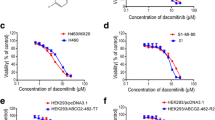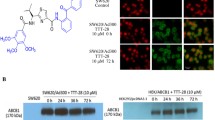Abstract
Purpose
Multidrug efflux pumps such as ABCG2 confer drug resistance to a number of cancer types, leading to poor prognosis and outcome. To date, the strategy of directly inhibiting multidrug efflux pumps in order to overcome drug resistance in cancer has been unsuccessful. An alternative strategy is to target proteins involved in the regulation of multidrug efflux pump activity or expression. Pim1 kinase has been demonstrated to phosphorylate ABCG2, promote its oligomerisation and contribute to its ability to confer drug resistance.
Methods
In the present manuscript, imidazo-pyridazine-based inhibitors of Pim1 were examined for their ability to overcome ABCG2-mediated drug resistance. Drug efficacy was measured as a cytotoxic response or an effect on transport by ABCG2. Protein expression patterns were assessed using western immuno-blotting.
Results
The two Pim1 inhibitors increased the potency of flavopiridol, mitoxantrone, topotecan and doxorubicin, specifically in ABCG2-expressing cells. This effect was associated with an increase in the cellular accumulation of [3H]-mitoxantrone, suggesting direct impairment of the transporter. However, prolonged pre-incubation with the studied inhibitors greatly enhanced the effect on mitoxantrone accumulation. The inhibitors caused a significant time-dependent reduction in the expression of ABCG2 in the resistant cells, an effect that would improve drug efficacy.
Conclusion
Consequently, it appears that the Pim1 inhibitors display a dual-mode effect on ABCG2-expressing cancer cells. This may provide a powerful new strategy in overcoming drug resistance by targeting proteins that regulate expression of efflux pumps.





Similar content being viewed by others
References
Doyle LA, Yang WD, Abruzzo LV, Krogmann T, Gao YM, Rishi AK, Ross DD (1998) A multidrug resistance transporter from human MCF-7 breast cancer cells. Proc Natl Acad Sci USA 95(26):15665–15670
Robey RW, Medina-Perez WY, Nishiyama K, Lahusen T, Miyake K, Litman T, Senderowicz AM, Ross DD, Bates SE (2001) Overexpression of the ATP-binding cassette half-transporter, ABCG2 (MXR/BCRP/ABCP1), in flavopiridol-resistant human breast cancer cells. Clin Cancer Res 7(1):145–152
Fellner S, Bauer B, Miller DS, Schaffrik M, Fankhanel M, Spruss T, Bernhardt G, Graeff C, Farber L, Gschaidmeier H, Buschauer A, Fricker G (2002) Transport of paclitaxel (Taxol) across the blood-brain barrier in vitro and in vivo. J Clin Investig 110(9):1309–1318
Robey RW, Polgar O, Deeken J, To KW, Bates SE (2007) ABCG2: determining its relevance in clinical drug resistance. Cancer Metastasis Rev 26(1):39–57. doi:10.1007/s10555-007-9042-6
Ross DD, Wooten PJ, Tong Y, Cornblatt B, Levy C, Sridhara R, Lee EJ, Schiffer CA (1994) Synergistic reversal of multidrug-resistance phenotype in acute myeloid-leukemia cells by cyclosporine-A and cremophor EL. Blood 83(5):1337–1347
Scheffer GL, Maliepaard M, Pijnenborg ACLM, van Gastelen MA, de Jong MC, Schroeijers AB, van der Kolk DM, Allen JD, Ross DD, van der Valk P, Dalton WS, Schellens JHM, Scheper RJ (2000) Breast cancer resistance protein is localized at the plasma membrane in mitoxantrone- and topotecan-resistant cell lines. Cancer Res 60(10):2589–2593
Ozvegy C, Litman T, Szakacs G, Nagy Z, Bates S, Varadi A, Sarkadi B (2001) Functional characterization of the human multidrug transporter, ABCG2, expressed in insect cells. Biochem Biophys Res Commun 285(1):111–117. doi:10.1006/bbrc.2001.5130
McDevitt CA, Collins RF, Conway M, Modok S, Storm J, Kerr ID, Ford RC, Callaghan R (2006) Purification and 3D structural analysis of oligomeric human multidrug transporter ABCG2. Structure 14(11):1623–1632. doi:10.1016/j.str.2006.08.014
Diop NK, Hrycyna CA (2005) N-linked glycosylation of the human ABC transporter ABCG2 on asparagine 596 is not essential for expression, transport activity, or trafficking to the plasma membrane. Biochemistry 44(14):5420–5429. doi:10.1021/Bi0479858
Henriksen U, Fog JU, Litman T, Gether U (2005) Identification of intra- and intermolecular disulfide bridges in the multidrug resistance transporter ABCG2. J Biol Chem 280(44):36926–36934. doi:10.1074/jbc.M502937200
Polgar O, Robey RW, Morisaki K, Dean M, Michejda C, Sauna ZE, Ambudkar SV, Tarasova N, Bates SE (2004) Mutational analysis of ABCG2: role of the GXXXG motif. Biochemistry 43(29):9448–9456. doi:10.1021/Bi0497953
Takada T, Suzuki H, Gotoh Y, Sugiyama Y (2005) Regulation of the cell surface expression of human BCRP/ABCG2 by the phosphorylation state of Akt in polarized cells. Drug Metab Dispos 33(7):905–909. doi:10.1124/dmd.104.003228
Xie Y, Xu K, Linn DE, Yang X, Guo Z, Shimelis H, Nakanishi T, Ross DD, Chen H, Fazli L, Gleave ME, Qiu Y (2008) The 44-kDa Pim-1 kinase phosphorylates BCRP/ABCG2 and thereby promotes its multimerization and drug-resistant activity in human prostate cancer cells. J Biol Chem 283(6):3349–3356. doi:10.1074/jbc.M707773200
Mogi M, Yang J, Lambert JF, Colvin GA, Shiojima I, Skurk C, Summer R, Fine A, Quesenberry PJ, Walsh K (2003) Akt signaling regulates side population cell phenotype via Bcrp1 translocation. J Biol Chem 278(40):39068–39075. doi:10.1074/jbc.M306362200
Krishnan N, Pan HQ, Buckley DJ, Buckley AR (2003) Prolactin-regulated Pim-1 transcription. Endocrine 20(1–2):123–129. doi:10.1385/Endo:20:1-2:123
Shah N, Pang B, Yeoh KG, Thorn S, Chen CS, Lilly MB, Salto-Tellez M (2008) Potential roles for the PIM1 kinase in human cancer—a molecular and therapeutic appraisal. Eur J Cancer 44(15):2144–2151. doi:10.1016/j.ejca.2008.06.044
Saris CJM, Domen J, Berns A (1991) The Pim-1 oncogene encodes 2 related protein-serine threonine kinases by alternative initiation at AUG and CUG. EMBO J 10(3):655–664
Leverson JD, Koskinen PJ, Orrico FC, Rainio EM, Jalkanen KJ, Dash AB, Eisenman RN, Ness SA (1998) Pim-1 kinase and p100 cooperate to enhance c-Myb activity. Mol Cell 2(4):417–425. doi:10.1016/S1097-2765(00)80141-0
Mochizuki T, Kitanaka C, Noguchi K, Muramatsu T, Asai A, Kuchino Y (1999) Physical and functional interactions between Pim-1 kinase and Cdc25A phosphatase—implications for the Pim-1-mediated activation of the c-Myc signaling pathway. J Biol Chem 274(26):18659–18666. doi:10.1074/jbc.274.26.18659
Koike N, Maita H, Taira T, Ariga H, Iguchi-Ariga SMM (2000) Identification of heterochromatin protein 1 (HP1) as a phosphorylation target by Pim-1 kinase and the effect of phosphorylation on the transcriptional repression function of HP1. FEBS Lett 467(1):17–21. doi:10.1016/S0014-5793(00)01105-4
Xie XM, Zhao XQ, Liu YF, Zhang JF, Matusik RJ, Slawin KM, Spencer DM (2001) Adenovirus-mediated tissue-targeted expression of a caspase-9-based artificial death switch for the treatment of prostate cancer. Cancer Res 61(18):6795–6804
Palaty CK, ClarkLewis I, Leung D, Pelech SL (1997) Phosphorylation site substrate specificity determinants for the Pim-1 protooncogene-encoded protein kinase. Biochem Cell Biol-Biochimie Et Biologie Cellulaire 75(2):153–162. doi:10.1139/Bcb-75-2-153
Mumenthaler SM, Ng PYB, Hodge A, Bearss D, Berk G, Kanekal S, Redkar S, Taverna P, Agus DB, Jain A (2009) Pharmacologic inhibition of Pim kinases alters prostate cancer cell growth and resensitizes chemoresistant cells to taxanes. Mol Cancer Ther 8(10):2882–2893. doi:10.1158/1535-7163.Mct-09-0293
Pogacic V, Bullock AN, Fedorov O, Filippakopoulos P, Gasser C, Biondi A, Meyer-Monard S, Knapp S, Schwaller J (2007) Structural analysis identifies imidazo[1,2-b]pyridazines as PIM kinase inhibitors with In vitro antileukemic activity. Cancer Res 67(14):6916–6924. doi:10.1158/0008-5472.Can-07-0320
Bullock AN, Debreczeni J, Amos AL, Knapp S, Turk BE (2005) Structure and substrate specificity of the Pim-1 kinase. J Biol Chem 280(50):41675–41682. doi:10.1074/jbc.M510711200
Bullock AN, Debreczeni JE, Fedorov OY, Nelson A, Marsden BD, Knapp S (2005) Structural basis of inhibitor specificity of the human protooncogene proviral insertion site in moloney murine leukemia virus (PIM-1) kinase. J Med Chem 48(24):7604–7614. doi:10.1021/jm0504858
Isaac M, Siu A, Jongstra J (2011) The oncogenic PIM kinase family regulates drug resistance through multiple mechanisms. Drug Resist Updates 14(4–5):203–211. doi:10.1016/j.drup.2011.04.002
Scudiero DA, Monks A, Sausville EA (1998) Cell line designation change: multidrug-resistant cell line in the NCI anticancer screen. J Natl Cancer Inst 90(11):862
Rivers F, O’Brien TJ, Callaghan R (2008) Exploring the possible interaction between anti-epilepsy drugs and multidrug efflux pumps; in vitro observations. Eur J Pharmacol 598(1–3):1–8. doi:10.1016/j.ejphar.2008.09.014
Moroy T, Grzeschiczek A, Petzold S, Hartmann KU (1993) Expression of a Pim-1 transgene accelerates lymphoproliferation and inhibits apoptosis in lpr/lpr mice. Proc Natl Acad Sci USA 90(22):10734–10738
Moroy T, Verbeek S, Ma A, Achacoso P, Berns A, Alt F (1991) E mu N- and E mu L-myc cooperate with E mu Pim-1 to generate lymphoid tumors at high frequency in double-transgenic mice. Oncogene 6(11):1941–1948
Nieborowska-Skorska M, Hoser G, Kossev P, Wasik MA, Skorski T (2002) Complementary functions of the antiapoptotic protein A1 and serine/threonine kinase Pim-1 in the BCR/ABL-mediated leukemogenesis. Blood 99(12):4531–4539
Selten G, Cuypers HT, Berns A (1985) Proviral activation of the putative oncogene Pim-1 in MuLV induced T-cell lymphomas. EMBO J 4(7):1793–1798
Bachmann M, Moroy T (2005) The serine/threonine kinase Pim-1. Int J Biochem Cell Biol 37(4):726–730. doi:10.1016/j.biocel.2004.11.005
Guo S, Mao X, Chen J, Huang B, Jin C, Xu Z, Qiu S (2010) Overexpression of Pim-1 in bladder cancer. J Exp Clin Cancer Res 29:161. doi:10.1186/1756-9966-29-161
Wang Z, Bhattacharya N, Weaver M, Petersen K, Meyer M, Gapter L, Magnuson NS (2001) Pim-1: a serine/threonine kinase with a role in cell survival, proliferation, differentiation and tumorigenesis. J Vet Sci 2(3):167–179
White E (2003) The pims and outs of survival signalling: role for the Pim-2 protein kinase in the suppression of apoptosis by cytokines. Genes Dev 17(15):1813–1816. doi:10.1101/gad.1123103
Qian KC, Wang L, Hickey ER, Studts J, Barringer K, Peng C, Kronkaitis A, Li J, White A, Mische S, Farmer B (2005) Structural basis of constitutive activity and a unique nucleotide binding mode of human Pim-1 kinase. J Biol Chem 280(7):6130–6137. doi:10.1074/jbc.M409123200
Swords R, Kelly K, Carew J, Nawrocki S, Mahalingam D, Sarantopoulos J, Bearss D, Giles F (2011) The Pim kinases: new targets for drug development. Curr Drug Targets 12(14):2059–2066
Nakanishi T, Ross DD (2012) Breast cancer resistance protein (BCRP/ABCG2): its role in multidrug resistance and regulation of its gene expression. Chin J Cancer 31(2):73–99. doi:10.5732/cjc.011.10320
Rabindran SK, Ross DD, Doyle LA, Yang W, Greenberger LM (2000) Fumitremorgin C reverses multidrug resistance in cells transfected with the breast cancer resistance protein. Cancer Res 60(1):47–50
Natarajan K, Bhullar J, Shukla S, Burcu M, Chen ZS, Ambudkar SV, Baer MR (2013) The Pim kinase inhibitor SGI-1776 decreases cell surface expression of P-glycoprotein (ABCB1) and breast cancer resistance protein (ABCG2) and drug transport by Pim-1-dependent and -independent mechanisms. Biochem Pharmacol 85(4):514–524. doi:10.1016/j.bcp.2012.12.006
Callaghan R, Crowley E, Potter S, Kerr ID (2008) P-glycoprotein: so many ways to turn it on. J Clin Pharmacol 48(3):365–378
Nakanishi T, Shiozawa K, Hassel BA, Ross DD (2006) Complex interaction of BCRP/ABCG2 and imatinib in BCR-ABL-expressing cells: BCRP-mediated resistance to imatinib is attenuated by imatinib-induced reduction of BCRP expression. Blood 108(2):678–684. doi:10.1182/blood-2005-10-4020
Acknowledgments
This investigation was funded by a project Grant (090072/Z/09/Z) from the Wellcome Trust awarded to Richard Callaghan and Stefan Knapp. SK is grateful for support by the SGC, a registered charity (number 1097737) that receives funds from AbbVie, Bayer, Boehringer Ingelheim, the Canada Foundation for Innovation, the Canadian Institutes for Health Research, Genome Canada, GlaxoSmithKline, Janssen, Lilly Canada, the Novartis Research Foundation, the Ontario Ministry of Economic Development and Innovation, Pfizer, Takeda, and the Wellcome Trust (092809/Z/10/Z).
Author information
Authors and Affiliations
Corresponding author
Rights and permissions
About this article
Cite this article
Darby, R.A.J., Unsworth, A., Knapp, S. et al. Overcoming ABCG2-mediated drug resistance with imidazo-[1,2-b]-pyridazine-based Pim1 kinase inhibitors. Cancer Chemother Pharmacol 76, 853–864 (2015). https://doi.org/10.1007/s00280-015-2858-9
Received:
Accepted:
Published:
Issue Date:
DOI: https://doi.org/10.1007/s00280-015-2858-9




